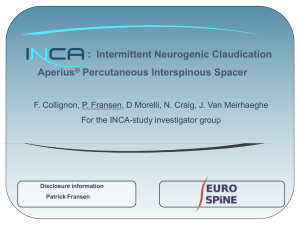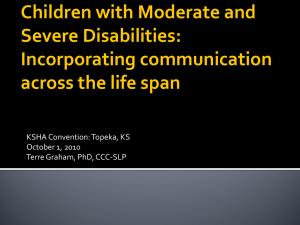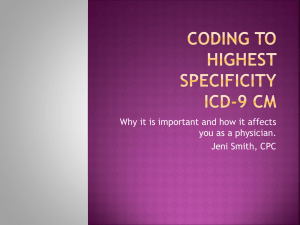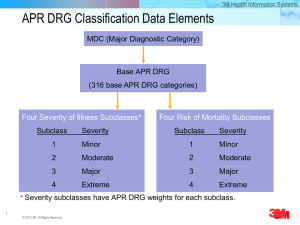doc
advertisement
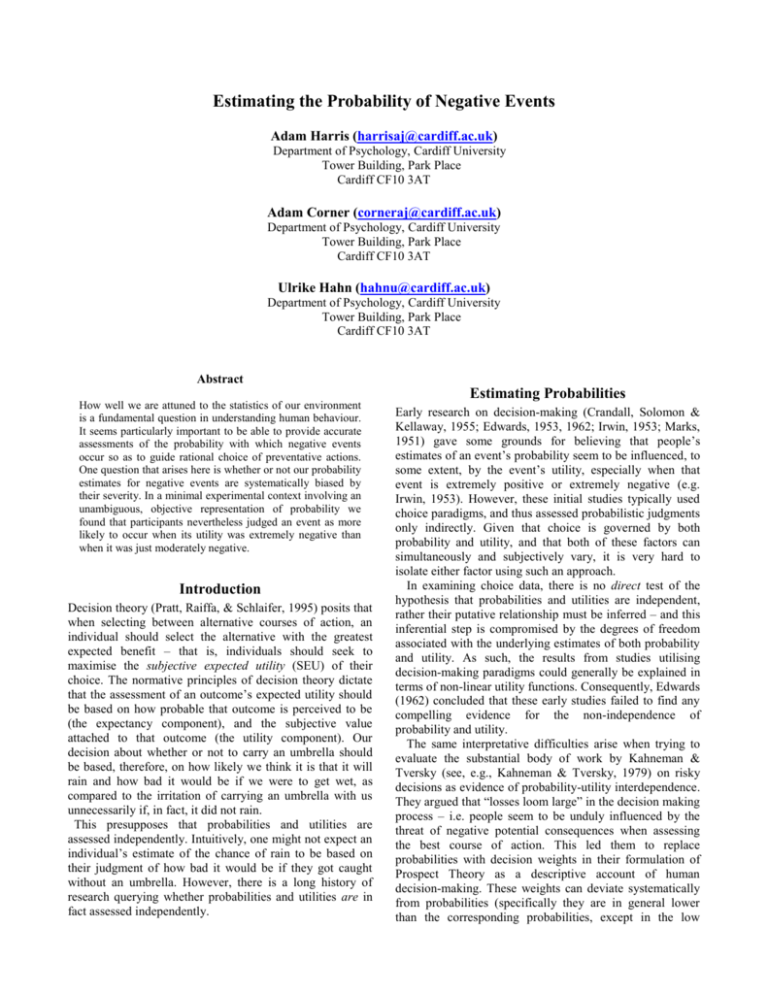
Estimating the Probability of Negative Events Adam Harris (harrisaj@cardiff.ac.uk) Department of Psychology, Cardiff University Tower Building, Park Place Cardiff CF10 3AT Adam Corner (corneraj@cardiff.ac.uk) Department of Psychology, Cardiff University Tower Building, Park Place Cardiff CF10 3AT Ulrike Hahn (hahnu@cardiff.ac.uk) Department of Psychology, Cardiff University Tower Building, Park Place Cardiff CF10 3AT Abstract How well we are attuned to the statistics of our environment is a fundamental question in understanding human behaviour. It seems particularly important to be able to provide accurate assessments of the probability with which negative events occur so as to guide rational choice of preventative actions. One question that arises here is whether or not our probability estimates for negative events are systematically biased by their severity. In a minimal experimental context involving an unambiguous, objective representation of probability we found that participants nevertheless judged an event as more likely to occur when its utility was extremely negative than when it was just moderately negative. Introduction Decision theory (Pratt, Raiffa, & Schlaifer, 1995) posits that when selecting between alternative courses of action, an individual should select the alternative with the greatest expected benefit – that is, individuals should seek to maximise the subjective expected utility (SEU) of their choice. The normative principles of decision theory dictate that the assessment of an outcome’s expected utility should be based on how probable that outcome is perceived to be (the expectancy component), and the subjective value attached to that outcome (the utility component). Our decision about whether or not to carry an umbrella should be based, therefore, on how likely we think it is that it will rain and how bad it would be if we were to get wet, as compared to the irritation of carrying an umbrella with us unnecessarily if, in fact, it did not rain. This presupposes that probabilities and utilities are assessed independently. Intuitively, one might not expect an individual’s estimate of the chance of rain to be based on their judgment of how bad it would be if they got caught without an umbrella. However, there is a long history of research querying whether probabilities and utilities are in fact assessed independently. Estimating Probabilities Early research on decision-making (Crandall, Solomon & Kellaway, 1955; Edwards, 1953, 1962; Irwin, 1953; Marks, 1951) gave some grounds for believing that people’s estimates of an event’s probability seem to be influenced, to some extent, by the event’s utility, especially when that event is extremely positive or extremely negative (e.g. Irwin, 1953). However, these initial studies typically used choice paradigms, and thus assessed probabilistic judgments only indirectly. Given that choice is governed by both probability and utility, and that both of these factors can simultaneously and subjectively vary, it is very hard to isolate either factor using such an approach. In examining choice data, there is no direct test of the hypothesis that probabilities and utilities are independent, rather their putative relationship must be inferred – and this inferential step is compromised by the degrees of freedom associated with the underlying estimates of both probability and utility. As such, the results from studies utilising decision-making paradigms could generally be explained in terms of non-linear utility functions. Consequently, Edwards (1962) concluded that these early studies failed to find any compelling evidence for the non-independence of probability and utility. The same interpretative difficulties arise when trying to evaluate the substantial body of work by Kahneman & Tversky (see, e.g., Kahneman & Tversky, 1979) on risky decisions as evidence of probability-utility interdependence. They argued that “losses loom large” in the decision making process – i.e. people seem to be unduly influenced by the threat of negative potential consequences when assessing the best course of action. This led them to replace probabilities with decision weights in their formulation of Prospect Theory as a descriptive account of human decision-making. These weights can deviate systematically from probabilities (specifically they are in general lower than the corresponding probabilities, except in the low probability range), whilst actual estimates of probabilities can be assumed to remain intact. An alternative possibility would be to assume that subjective probabilities themselves are systematically distorted. What is really required to support this latter interpretation, however, is a direct test. The remaining evidence for the existence of a dependency between probability judgments and outcome severity is also indirect in nature, and typically comes from empirical studies whose primary focus was elsewhere. Some support for the idea that utilities influence probability estimates could be taken from research on the subjective interpretation of probability words (e.g. Weber & Hilton, 1990). The concept of probability is inherently numerical, yet we often communicate probabilities through verbal descriptors such as “unlikely”, “possible” and “probable”. Several empirical studies have attempted to investigate how such verbal statements are selected and interpreted. An example is provided by Wallsten, Fillenbaum, and Cox (1986, p. 574, italics added) whereby participants were instructed to respond with either a single probability or a probability range: ‘You have a wart removed from your hand. The doctor tells you it is possible it will grow back again within 3 months. What is the probability it will grow back again within 3 months?_________’ People’s numerical interpretations of verbal probabilities were found to depend on the outcome that was being estimated – suggesting that the interpretation of probabilistic information is context bound (see also Beyth-Marom, 1982; Brun & Teigen, 1988). A key influence on people’s interpretations is the base rate of the event under discussion (e.g. Wallsten, Fillenbaum, et al., 1986). However, within the study of context effects, there is also somewhat weak and conflicting evidence of the influence of outcome utility on subjective judgments of outcome probability. Weber and Hilton (1990) (see also Verplanken, 1997) found that verbal probability expressions were assigned higher numerical probabilities when they referred to a severe (i.e. very negative) event as opposed to a more neutral event. Opposite findings, whereby probability expressions referring to more severe events are given lower numerical values than those referring to more neutral events, have also been reported (Fischer & Jungermann, 1996; Merz, Druzdzel, & Mazur, 1991). Crucially, however, there is nothing in this literature to suggest that these effects are governed by anything other than the pragmatics of language use (see, e.g. Grice, 2001). Context effects on the interpretation and selection of vague terms are ubiquitous. There exist, for example, studies demonstrating the effect of context on people’s interpretations of verbal expressions of quantity. Borges and Sawyers (1974) and Cohen, Dearnley, and Hansel (1958), demonstrated that when participants were asked to select “a few”, “some”, or “several” marbles from a tray, the absolute number of marbles selected was dependent upon the total number of marbles in the tray. Our interpretation of the exact numerical meaning of such quantifiers depends to some extent on what they are referring to. Hence, the most parsimonious interpretation of any potential influence of severity on the interpretation of probability expressions is that it serves a communicative intent. One cannot infer from contextually bound variation in the numerical interpretation of verbal probability statements that people’s actual probability estimates are distorted by the utility of the outcome. A further source that might suggest that people’s utilities systematically bias their probability estimates is research on people’s estimates of personal risk for negative life events. A sizeable literature reports that people are prone to “unrealistic optimism” (Kirscht, Haefner, Kegeles & Rosenstock, 1966; Weinstein, 1980, 1982, 1984). Individuals frequently regard their own personal risk to be less than that of the average person, displaying a kind of “invulnerability bias”. On the assumption that one’s own illnesses are subjectively more negative events than another’s illnesses (in particular, if the “other” is simply the ‘average person’) this would suggest that the increased severity of an event leads to a (protective) depression of estimated probability (in contrast to the relationship between these variables posited by Weber & Hilton, 1990). As the range of negative life events included in these studies typically varies, examinations of correlations between the degree of unrealistic optimism and severity of event can test this interpretation more directly. It turns out that there is no evidence for such a relationship once other relevant variables are controlled for (Eiser, Eiser & Pauwels, 1993; Heine & Lehman, 1995; van der Velde, Hooykas & van Pligt, 1992; van der Velde, van der Pligt & Hooykas, 1994; Weinstein, 1982, 1987, Weinstein, Sandman & Roberts, 1990)1. Another reason to believe that the severity of negative events might influence estimates of probability stems from the fact that some research has suggested that positive events give rise to systematic distortions (e.g. Babad & Katz, 1991; Price, 2000). Attempts to find evidence that people rate the probability of desirable outcomes to be higher than less desirable outcomes under controlled, laboratory conditions, however, have been less successful, leading some researchers to speak of the “elusive wishful thinking effect” (Bar-Hillel & Budescu, 1995). Finally, there is reason to believe that peoples’ information accumulation can be affected by utilities (e.g., Slovic, 1966). Gordon, Franklin and Beck (2005), for 1 The only exception is an experimental study by Taylor and Shepperd (1998) who led participants to believe they were being tested for a medical condition with either severe or non-severe consequences. An effect of severity was found such that when participants were told that test results were imminent, optimism was eliminated in the severe condition. This effect, seems down to a desire to ‘not jinx’ things. No effect of severity was found in participants who did not expect feedback. example, found evidence that people misremembering the source of predictions had a tendency to attribute more desirable predictions to the more reliable source. Such influences on information accumulation could give rise to severity-related distortions of probability estimates; however, this leaves open the question of the generality of such influences, in particular, the question of whether or not severity influences probability estimates even in circumstances where all relevant information is readily available. In summary, despite a long history of research potentially suggesting an influence of outcome utility on probability judgments for outcomes of both positive and negative valence, to the best of our knowledge there exists no clear demonstration of the direct effect of outcome severity on perceived outcome probability. Consequently, we sought to investigate estimates of negative events using a novel paradigm that allowed us to provide a direct test of the independence of probability judgments. A Direct Test of Severity Influence Are severe outcomes perceived as more probable, or less probable, than neutral outcomes? In attempting to answer this fundamental question, it seems necessary to dispose of as many potential confounds as possible, and avoid the ambiguities that trouble the interpretation of verbal probability expressions. We therefore wanted a task in which participants provided numerical estimates. The main difficulty in choosing appropriate materials for such estimates is that severity and probability are confounded in the real world (see also, e.g., Weber & Hilton, 1990), such that ‘really bad’ things are less frequent than ‘moderately bad’ or neutral ones. Simply comparing estimates across events of different severity would consequently be uninformative in respect of establishing a bias. What is minimally required is an objective measure of the probabilities involved. As such measures are difficult to obtain, and because differences in knowledge between people could furthermore give rise to rational deviations from these objective probabilities, we chose to develop fictitious scenarios. Crucial to our experimental design is the fact that participants are supplied with an objective basis for their subjective estimates and that this objective basis is identical across the severity manipulations. Any systematic difference that arises in participants’ estimates of probability across conditions is consequently directly attributable to the influence of severity. Experiment 1 The purpose of the first experiment was to provide a direct demonstration of the effect of extreme negative outcome utility (outcome severity) on estimates of outcome probability using a paradigm in which these estimates are anchored to an objective probability to which all participants have equal access. Specifically, the relevant probabilities were provided in a visual display. The use of visual displays as a means of supplying probability information to participants has considerable precedent in the literature (e.g., Bar-Hillel & Budescu, 1995; Cohen & Wallsten, 1991; Wallsten, Budescu, Rapoport, Zwick, & Forsyth, 1986), but has not been used to directly investigate the relationship between outcome severity and probability. Participants saw cell matrices in which different colored cells represented different outcomes. To make the interpretation of these matrices more natural, the cover story was chosen such that the spatial arrangement of the cells had a straightforward real-world correspondence. Specifically, the cells were presented as a graphical representation of a large apple orchard. Yellow cells corresponded to apple trees that had been treated with a pesticide; black cells corresponded to untreated apple trees. The matrix was made sufficiently large that counting the number of cells would have been unduly tedious, thus ensuring that participants would be giving estimates even though they were being presented with an objective probability. The cover story associated with the display varied the significance of the treated apples such that they were either fatally poisonous (the severe outcome) or tasted unpleasant (the neutral outcome). Participants were allocated to either the severe or the neutral cover story and asked to provide a probability estimate for the event in question. Crucially, however, all participants saw exactly the same visual displays. The paradigm therefore provided a direct test of the hypothesis that outcome utility may alter the subjective probability of that event occurring. Method Participants One hundred participants took part in Experiment 1. The experiment was conducted remotely using an internet host (iPsychExpts). Fifty-five female and forty-five male participants with a mean age of 30 completed the experiment, in an average time of 2.54 minutes. Fifty participants provided probability estimates of severe outcomes, and fifty provided probability estimates of neutral outcomes. Design Experiment 1 was designed to test the hypothesis that probability estimates of severe outcomes are overestimated relative to the probability of neutral events. This hypothesis was tested using visual response matrices containing varying proportions of black and yellow cells. Outcomeseverity was manipulated between-participants, such that the yellow cells in the display matrices corresponded to outcomes of either extremely negative or neutral utility. The number of yellow cells in the display matrices was manipulated within-participants, such that everyone gave three estimates of probability (low/medium/high outcome probability). Materials and Procedure A visual display containing 2236 square cells with a random distribution of black and yellow squares was constructed with a simple JAVA program designed specifically for the experiment (see Fig 1). Three different variants of the display were created, corresponding to the three levels of outcome probability manipulated in the experiment. In the low probability condition of the experiment, the randomly distributed yellow cells were constrained to occupy less than 5% of the display. In the medium probability condition, 50% of the cells in the display were yellow. In the high probability condition, more than 95% of the cells in the display were yellow. Neutral Outcome: A farmer has just bought an orchard that contains over 1000 apple trees. The picture below shows the layout of the orchard, with each coloured circle representing an apple tree. Trees that are coloured BLACK bear fruit that is tasty, and delicious to eat. Trees that are coloured YELLOW bear fruit that is sour, and unsuitable for eating. Unfortunately, however, there is no way of knowing whether an apple tree bears edible or inedible fruit without trying an apple from the tree (the colours black and yellow simply represent the different types of apple). In the severe outcome condition, participants were asked by the farmer to “estimate the chance of his daughter choosing an apple from a tree that bears fatally poisonous fruit (BLACK), if she were to randomly pick an apple from any of the trees in the orchard”. In the neutral outcome condition, participants were asked to estimate the chance of the daughter picking a sour and inedible apple. Probability estimates were made on a numerical scale from 0% (Absolutely Impossible) to 100% (Absolutely Certain) with 5 point increments. Participants responded by clicking on a radio button. Results Figure 1: An example cell matrix (from the medium probability level). Depending on the outcome-severity condition participants were randomly assigned to, they read one of the following cover stories: Severe Outcome: A farmer has just bought an orchard that contains over 1000 apple trees. The picture below shows the layout of the orchard, with each coloured circle representing an apple tree. Trees that are coloured BLACK bear fruit that is tasty, and delicious to eat. Trees that are coloured YELLOW have been sprayed with a particularly potent type of pesticide, and bear fruit that is fatally poisonous to humans. The farmer’s young daughter is always playing in the orchard, and despite her father’s warnings, she often picks apples to eat from the trees in the orchard. Unfortunately, however, there is no way of knowing whether an apple tree bears edible or inedible fruit without trying an apple from the tree (the colours black and yellow simply represent the different types of apple). The safety of his daughter is extremely important to the farmer, who is very concerned that she might eat a poisonous apple by mistake. As the experiment was conducted remotely using an internet experiment host, we followed Birnbaum (2004) and performed several basic checks prior to data analysis. All participants under the age of 18 were excluded (in line with the ethical guidelines of the British Psychological Society), data from the same Internet Protocol (IP) address were excluded (in order to guard against multiple entries from the same individual), and participants with demographic details that aroused suspicion of fabrication (e.g. an age entry of 99) were eliminated from subsequent analysis. In addition, we excluded participants who had obviously failed to understand the instructions in that they had provided estimates of the three, clearly distinct, levels of probability that deviated from their basic rank order. Participants who took longer then 15 minutes to complete such a basic task were also excluded, to ensure that people were estimating, and not counting the squares. Following these exclusions, 76 participants were included in the analysis, 43 in the severe outcome condition, and 33 in the neutral outcome condition. A preliminary analysis was conducted to establish that the probability manipulation (i.e. the proportion of yellow cells in the display matrices) had in fact produced differentiated probability estimates. Collapsing across both outcome severity conditions, a significant main effect of probability in the expected direction was observed; F(2, 148) = 1003.6, p< .001. More importantly, Figure 2 displays these probability estimates, but split by outcome severity condition. At each level of the probability manipulation, the estimated proportion of yellow cells in the display matrices was higher in the severe outcome condition, producing an overall main effect of outcome severity, F(1, 74) = 9.88, p< .01. The probability x severity interaction was non significant, F(2, 148) = 1.606, p>.05. Mean probability estimate Discussion 100 90 80 70 60 Neutral Outcome 50 40 30 20 10 0 Severe Outcome Low Medium High Probability Level Figure 2: The effect of outcome utility on probability judgments. Error bars represent 95% confidence intervals. Experiment 2 Finding a statistically significant effect of outcome severity on judgments of probability in such a minimal paradigm with a patently fictitious story of no personal relevance to participants was sufficiently surprising that we sought to replicate this result. Experiment 2 is a direct replication of Experiment 1 with a different set of participants. Method Participants One hundred participants took part in Experiment 2. The experiment was conducted remotely using an internet host (iPsychExpts). Fifty-two female and forty-eight male participants with a mean age of 26 completed the experiment, in an average time of 2.56 minutes. Design, Materials and Procedure Experiment 2 was an exact methodological replication of Experiment 1. Results The same basic checks were undertaken prior to analysis as were performed in Experiment 1. On this occasion however, data collection continued until there were 50 participants suitable for analysis, after exclusions, in each experimental group. The results obtained were very similar to those obtained in Experiment 1. A main effect of probability, F(2, 196) = 1656.08, p< .001, indicated that the within-participants probability manipulation had been successful. Once again, the estimated proportion of yellow cells in the display matrices was higher in the severe outcome condition at all levels of the probability manipulation, producing an overall main effect of severity F(1, 98) = 4.07, p< .05. The probability x severity interaction was, again, non significant, F(2, 196) = .004, p>.05. Our results provide direct empirical evidence that event severity influences probability judgments. In a minimal experimental paradigm, we found that participants judged the probability of a negative outcome to be higher than that of a directly matched neutral outcome. The fact that both groups of participants in our experiments were presented with identical visual representations of the underlying probabilities, and differed only in the severity manipulation included in the cover story, enables us to infer with confidence that the differences in their probability estimates were attributable to that severity manipulation. That estimates of outcome severity and probability might interact is an idea with a long research history. However, this is, to our knowledge, the first direct test of this idea. The actual nature of the effect is also at odds with at least some of the potential evidence for severity-probability interactions that could be drawn from past research. In particular, the fact that negative outcomes give rise to higher estimates across the probability scale is incompatible with an alternative explanation of Kahneman and Tversky’s (1979) findings that “losses loom large” in terms of distorted probability estimates, as their findings would imply increased estimates only at low levels of probability, with lower estimates at all other levels. The most notable aspect of our results, however, must be that a systematic influence of severity on perceived probability could occur under such simple, well-defined conditions. In particular, participants have no personal stake in the probabilities they are providing, given that the story involves entirely fictitious third parties. Furthermore, there is a clear objective probability that is made available to participants. If a reliable and replicable effect of outcome utility on estimates of probability can be observed in such a reduced paradigm, there is reason to believe that influences of outcome severity on estimates of probability are pervasive and that they are likely to be considerably larger under conditions of emotional involvement as we might experience in day to day life. The immediate, practical importance of such effects mean that further investigations under more real-world circumstances are desirable. Given the fundamental importance of accurate probability judgment to our lives, such investigations should also include potential strategies to overcome this bias. References Babad, E., & Katz, Y. (1991). Wishful thinking – against all odds. Journal of Applied Social Psychology 21, 19211938. Bar-Hillel, M., & Budescu, D. (1995). The Elusive Wishful Thinking Effect. Thinking and Reasoning 1 (1) 71-103. Beyth-Marom, R. (1982). How probable is probable? a numerical translation of verbal probability expressions. Journal of Forecasting, 1, 257-269. Birnbaum, M. H. (2004). Human research and data collection via the internet. Annual Review of Psychology, 55, 803-832. Borges, M. A., & Sawyers, B. K. (1974). Common verbal quantifiers: usage and interpretation. Journal of Experimental Psychology, 102, 335-338. Brun, W., & Teigen, K. H. (1988). Verbal probabilities: ambiguous, context-dependent, or both? Organizational Behavior and Human Decision Processes, 41, 390-404. Cohen, B. L., & Wallsten, T. S. (1991). The effect of outcome desirability on comparisons of numerical and linguistic probabilities. Journal of Behavioral Decision Making, 5, 53-72. Cohen, J., Dearnley, E. J., & Hansel, C. E. M. (1958). A quantitative study of meaning. British Journal of Educational Psychology, 28, 141-148. Crandall, V.J., Solomon, D. & Kellaway, R. (1955). Expectancy statements and decision themes as functions of objective probabilities and reinforcement values. Journal of Personality 24, p192-203. Edwards, W. (1953). Probability preferences in gambling. American Journal of Psychology 66, 349-364. Edwards, W. (1962). Utility, subjective probability, their interaction, and variance preferences. Journal of Conflict resolution, 6, 42-51. Eiser, J.R., Eiser, C., & Pauwels, P. (1993). Skin cancer: Assessing perceived risk and behavioural attitudes. Psychology and Health, 8, 393-404. Fischer, K., & Jungermann, H. (1996). Rarely occurring headaches and rarely occurring blindness: Is rarely = rarely? Meaning of verbal frequentistic labels in specific medical contexts. Journal of Behavioral Decision Making, 9, 153-172. Gordon, R., Franklin, N., & Beck, J. (2005) Wishful thinking and source monitoring. Memory & Cognition, 33, 418-429. Grice, H.P. (2001). Aspects of Reason. Clarendon Press: Oxford. Heine, S.J., & Lehman, D.R. (1995). Cultural variation in unrealistic optimism: Does the West feel more invulnerable than the East? Journal of Personality and Social Psychology, 68, 595-607. Irwin, F. W. (1953). Stated expectations as functions of probability and desirability of outcomes. Journal of Personality, 21, 329-335. Kahneman, D., & Tversky, A. (1979). Prospect theory: an analysis of decision under risk. Econometrica, 47, 263291. Kirscht, J.F., Haefner, D.P., Kegeles, S.S., & Rosenstock, I.M. (1966). A national study of health beliefs. Journal of Health & Human Behaviour, 7, 248-254. Marks, R.W. (1951). The effect of probability, desirability and ‘privilege’ on the stated expectations of children. Journal of Personality 19, 332-351. Merz, J. F., Druzdzel, M. J., & Mazur, D. J. (1991). Verbal expressions of probability in informed consent litigation. Medical Decision Making, 11, 273-281. Pratt. J, Raiffa.H, & Schlaifer, R. (1995). Introduction to Statistical Decision Theory. Massachusetts: MIT Press. Price, P.C. (2000). Wishful thinking in the prediction of competitive outcomes. Thinking & Reasoning 6 (2) 161172. Slovic, P. (1966). Value as a determiner of subjective probability. IEEE Transactions on Human Factors in Electronics, HFE-7, 22-28. Taylor, K.M., & Shepperd, J.A. (1998). Bracing for the worst: Severity, testing and feedback as moderators of optimistic bias. Personality and Social Psychology Bulletin, 24, 9115-926. van der Velde, F.W. , Hooykas, C., & van der Pligt, J. (1992). Risk perception and behaviour. Pessimism, realism and optimism about AIDS-related health behaviour. Psychology and Health, 6, 23-38. van der Velde, F.W., van der Pligt & Hooykas, C. (1994). Perceiving AIDS related risk: Accuracy as a function of differences in actual risk. Health Psychology, 13, 25-33. Verplanken, B. (1997). The effect of catastrophe potential on the interpretation of numerical probabilities of the occurrence of hazards. Journal of Applied Social Psychology, 27, 1453-1467. Wallsten, T. S., Budescu, D. V., Rapoport, A., Zwick, R., & Forsyth, B. (1986). Measuring the vague meanings of probability terms. Journal of Experimental Psychology: General, 115, 348-365. Wallsten, T. S., Fillenbaum, S., & Cox, J. A. (1986). Baserate effects on the interpretations of probability words: perceived base rate and severity of events. Journal of Memory and Language, 25, 571-587. Weber, E. U., & Hilton, D. J. (1990). Contextual effects in the interpretations of probability words: perceived base rate and severity of events. Journal of Experimental Psychology: Human Perception and Performance, 16, 781-789. Weinstein, N.D. (1980). Unrealistic optimism about future life events. Journal of Personality & Social Psychology, 39, 806-820. Weinstein, N.D. (1982). Unrealistic optimism about susceptibility to health problems. Journal of Behavioural Medicine, 5, 441-460. Weinstein, N.D. (1984). Why it won’t happen to me: Perceptions of risk factors and susceptibility. Health Psychology, 3, 431-457. Weinstein, N.D. (1987) Unrealistic optimism about susceptibility to health problems: Conclusions from a community-wide sample. Journal of Behavioral Medicine, 10, 481-500. Weinstein, N.D., Sandman, P.M., & Roberts, N.E. (1990). Determinants of self-protective behaviour: Home radon testing. Journal of Applied Social Psychology, 20, 783801.

